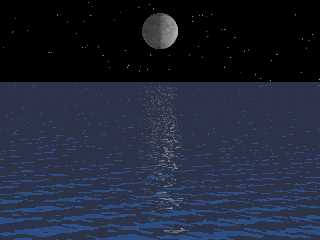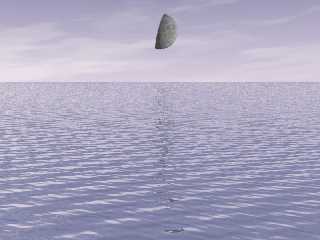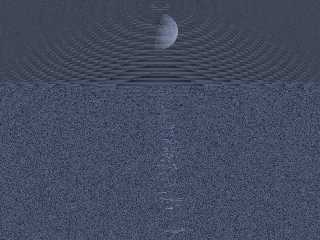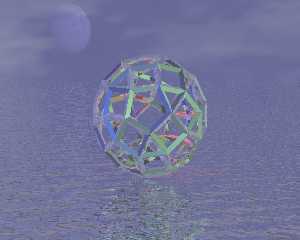 |
 |
|
 |
|
 |
|  |
|  |
|
 |
|
 |
|  |
|  |
|
 |
translating the moon out further produces a horizontal straight line of
reflection at the edge of the water. this part of the reflection would not be
seen because it is too far away on the horizon. here the moon isnot farther
than the edge of the water for that reason.
day time half moon seems to elude me at this point
Post a reply to this message
Attachments:
Download 'waterscene_02.png' (76 KB)
Preview of image 'waterscene_02.png'

|
 |
|  |
|  |
|
 |
|
 |
|  |
|  |
|
 |
Jan Dvorak <jan### [at] centrum cz> wrote:
> three layers:
> moon (prerendered)
> occlusion (probably grouped with the moon)
> sky (transparent)
> or:
> moon (sphere)
> an actual atmosphere (not as slow as you might think)
>
> the first variant is probably easier to do.
pre-rendered? that draws a blank.
it seems the right way, is to do the moon as seen here,
only with a cloud atmosphere between it and camera.
need more info on:
sky (transparent)
pre-rendered
I was able to remember vicky's hair and did this.
#declare p_map1=pigment {image_map{jpeg "moon" interpolate 2 transmit all 0
filter all 0} }
#declare p_map2=pigment {image_map{png "moontr" interpolate 2 }}
#declare halfmoon = texture{ pigment{ p_map1} }
#declare half_moon = material {
texture { pigment_pattern{ p_map2}
texture_map { [ 0 pigment{Clear} ]
[ 1 halfmoon ]
}
} cz> wrote:
> three layers:
> moon (prerendered)
> occlusion (probably grouped with the moon)
> sky (transparent)
> or:
> moon (sphere)
> an actual atmosphere (not as slow as you might think)
>
> the first variant is probably easier to do.
pre-rendered? that draws a blank.
it seems the right way, is to do the moon as seen here,
only with a cloud atmosphere between it and camera.
need more info on:
sky (transparent)
pre-rendered
I was able to remember vicky's hair and did this.
#declare p_map1=pigment {image_map{jpeg "moon" interpolate 2 transmit all 0
filter all 0} }
#declare p_map2=pigment {image_map{png "moontr" interpolate 2 }}
#declare halfmoon = texture{ pigment{ p_map1} }
#declare half_moon = material {
texture { pigment_pattern{ p_map2}
texture_map { [ 0 pigment{Clear} ]
[ 1 halfmoon ]
}
}
Post a reply to this message
Attachments:
Download 'waterscene_03.jpg' (63 KB)
Preview of image 'waterscene_03.jpg'

|
 |
|  |
|  |
|
 |
|
 |
|  |
|  |
|
 |
"alphaQuad" <alp### [at] earthlink net> schreef in bericht
news:web.472e20902a06dfe95b922c2d0@news.povray.org...
> "alphaQuad" <alp### [at] earthlink net> schreef in bericht
news:web.472e20902a06dfe95b922c2d0@news.povray.org...
> "alphaQuad" <alp### [at] earthlink net> wrote:
>> dont think I got the hang of it yet
>
>
> here's a curiosity: what can POV do?
>
> what about a half moon in the middle of the day?
>
This has been solved very nicely by Bill Pragnell (look for a message dated
november 23, 2005, I think in this same ng) and I have used the trick in
several of my scenes. I took some notes which I reproduce here:
1) use a hollow sphere around your scene (or use inverse) set background to
black
2) give it the required color gradient you would give a sky_sphere, but use
a partial transparency, ambient 1, diffuse 0
3) put the moon and the light source (sun) outside of this sphere: the parts
in shadow will have the same color as the local sky
4) if you want to use radiosity: use an interior_texture on your sphere. The
ouside texture should be rgb 0, with transmit=1
note 1: you may have to experiment a bit with the transparency and/or the
gradient colors to get the desired effect.
note 2: instead of a sphere, you can use other objects of course: a plane or
a cube or whatever.
Hope this helps
Thomas net> wrote:
>> dont think I got the hang of it yet
>
>
> here's a curiosity: what can POV do?
>
> what about a half moon in the middle of the day?
>
This has been solved very nicely by Bill Pragnell (look for a message dated
november 23, 2005, I think in this same ng) and I have used the trick in
several of my scenes. I took some notes which I reproduce here:
1) use a hollow sphere around your scene (or use inverse) set background to
black
2) give it the required color gradient you would give a sky_sphere, but use
a partial transparency, ambient 1, diffuse 0
3) put the moon and the light source (sun) outside of this sphere: the parts
in shadow will have the same color as the local sky
4) if you want to use radiosity: use an interior_texture on your sphere. The
ouside texture should be rgb 0, with transmit=1
note 1: you may have to experiment a bit with the transparency and/or the
gradient colors to get the desired effect.
note 2: instead of a sphere, you can use other objects of course: a plane or
a cube or whatever.
Hope this helps
Thomas
Post a reply to this message
|
 |
|  |
|  |
|
 |
|
 |
|  |
|  |
|
 |
alphaQuad nous apporta ses lumieres en ce 2007/11/04 14:42:
> "alphaQuad" <alp### [at] earthlink net> wrote:
>> dont think I got the hang of it yet
>
>
> here's a curiosity: what can POV do?
>
> what about a half moon in the middle of the day?
>
> night time sky is behind the moon and black. you might be able to
> air brush the map to black. yuck
>
> day time sky would eliminate that possibility being actually in back of moon.
> airbrushing to a gradient sky would be difficult at best.
>
> so can POV do either suggestion without touching the map.
>
> half moon night
> or half moon day
>
> day time moon would darken at half point then go transparent.
>
Half and cressent moon at night:
- use a sphere with the image_map of the moon surface, light it sideway, make it
part of a light_group.
- Use an image of a cressent or half moon where the dark part of the moon is NOT
transparent.
Both cases, use a sky_sphere for your stary background.
Day time:
- Two "world spheres", one with the moon, the second, slightly smaller,
sky-blue, filtering, with whatever gradiant and clouds you may want.
- Use an actual sphere with moon image behind your athmosphere, done whatever
way you want.
--
Alain
-------------------------------------------------
One tequila, two tequila, three tequila, floor. net> wrote:
>> dont think I got the hang of it yet
>
>
> here's a curiosity: what can POV do?
>
> what about a half moon in the middle of the day?
>
> night time sky is behind the moon and black. you might be able to
> air brush the map to black. yuck
>
> day time sky would eliminate that possibility being actually in back of moon.
> airbrushing to a gradient sky would be difficult at best.
>
> so can POV do either suggestion without touching the map.
>
> half moon night
> or half moon day
>
> day time moon would darken at half point then go transparent.
>
Half and cressent moon at night:
- use a sphere with the image_map of the moon surface, light it sideway, make it
part of a light_group.
- Use an image of a cressent or half moon where the dark part of the moon is NOT
transparent.
Both cases, use a sky_sphere for your stary background.
Day time:
- Two "world spheres", one with the moon, the second, slightly smaller,
sky-blue, filtering, with whatever gradiant and clouds you may want.
- Use an actual sphere with moon image behind your athmosphere, done whatever
way you want.
--
Alain
-------------------------------------------------
One tequila, two tequila, three tequila, floor.
Post a reply to this message
|
 |
|  |
|  |
|
 |
|
 |
|  |
|  |
|
 |
alphaQuad nous apporta ses lumieres en ce 2007/11/04 17:48:
> Jan Dvorak <jan### [at] centrum cz> wrote:
>> three layers:
>> moon (prerendered)
>> occlusion (probably grouped with the moon)
>> sky (transparent)
>> or:
>> moon (sphere)
>> an actual atmosphere (not as slow as you might think)
>>
>> the first variant is probably easier to do.
>
>
> pre-rendered? that draws a blank.
Pre-render:
Render the complete moon only lighted from the side with alpha chanel on: +ua.
Then use the result in the final render.
This ensure that the dark side of your moon won't let you see the stars behind it.
>
> it seems the right way, is to do the moon as seen here,
> only with a cloud atmosphere between it and camera.
>
> need more info on:
> sky (transparent)
> pre-rendered
>
>
>
>
> I was able to remember vicky's hair and did this.
>
> #declare p_map1=pigment {image_map{jpeg "moon" interpolate 2 transmit all 0
> filter all 0} }
> #declare p_map2=pigment {image_map{png "moontr" interpolate 2 }}
>
> #declare halfmoon = texture{ pigment{ p_map1} }
>
> #declare half_moon = material {
> texture { pigment_pattern{ p_map2}
> texture_map { [ 0 pigment{Clear} ]
> [ 1 halfmoon ]
> }
> }
>
>
> ------------------------------------------------------------------------
>
You used a sky_sphere, so the moon is before your "clouds".
You should use a large, filtering or transmiting sphere for your sky. Then place
your moon outside of it. Set the background to some gray or bluish gray.
--
Alain
-------------------------------------------------
You know you've been raytracing too long when you look at a matrix transform and
know instantly what it does.
John VanSickle cz> wrote:
>> three layers:
>> moon (prerendered)
>> occlusion (probably grouped with the moon)
>> sky (transparent)
>> or:
>> moon (sphere)
>> an actual atmosphere (not as slow as you might think)
>>
>> the first variant is probably easier to do.
>
>
> pre-rendered? that draws a blank.
Pre-render:
Render the complete moon only lighted from the side with alpha chanel on: +ua.
Then use the result in the final render.
This ensure that the dark side of your moon won't let you see the stars behind it.
>
> it seems the right way, is to do the moon as seen here,
> only with a cloud atmosphere between it and camera.
>
> need more info on:
> sky (transparent)
> pre-rendered
>
>
>
>
> I was able to remember vicky's hair and did this.
>
> #declare p_map1=pigment {image_map{jpeg "moon" interpolate 2 transmit all 0
> filter all 0} }
> #declare p_map2=pigment {image_map{png "moontr" interpolate 2 }}
>
> #declare halfmoon = texture{ pigment{ p_map1} }
>
> #declare half_moon = material {
> texture { pigment_pattern{ p_map2}
> texture_map { [ 0 pigment{Clear} ]
> [ 1 halfmoon ]
> }
> }
>
>
> ------------------------------------------------------------------------
>
You used a sky_sphere, so the moon is before your "clouds".
You should use a large, filtering or transmiting sphere for your sky. Then place
your moon outside of it. Set the background to some gray or bluish gray.
--
Alain
-------------------------------------------------
You know you've been raytracing too long when you look at a matrix transform and
know instantly what it does.
John VanSickle
Post a reply to this message
|
 |
|  |
|  |
|
 |
|
 |
|  |
|  |
|
 |
Thomas de Groot nous apporta ses lumieres en ce 2007/11/05 03:47:
> "alphaQuad" <alp### [at] earthlink net> schreef in bericht
> news:web.472e20902a06dfe95b922c2d0@news.povray.org...
>> "alphaQuad" <alp### [at] earthlink net> schreef in bericht
> news:web.472e20902a06dfe95b922c2d0@news.povray.org...
>> "alphaQuad" <alp### [at] earthlink net> wrote:
>>> dont think I got the hang of it yet
>>
>> here's a curiosity: what can POV do?
>>
>> what about a half moon in the middle of the day?
>>
>
> This has been solved very nicely by Bill Pragnell (look for a message dated
> november 23, 2005, I think in this same ng) and I have used the trick in
> several of my scenes. I took some notes which I reproduce here:
>
> 1) use a hollow sphere around your scene (or use inverse) set background to
> black
> 2) give it the required color gradient you would give a sky_sphere, but use
> a partial transparency, ambient 1, diffuse 0
> 3) put the moon and the light source (sun) outside of this sphere: the parts
> in shadow will have the same color as the local sky
> 4) if you want to use radiosity: use an interior_texture on your sphere. The
> ouside texture should be rgb 0, with transmit=1
>
> note 1: you may have to experiment a bit with the transparency and/or the
> gradient colors to get the desired effect.
> note 2: instead of a sphere, you can use other objects of course: a plane or
> a cube or whatever.
>
> Hope this helps
>
> Thomas
>
>
Additional note: the sphere center don't need to be at the camera location or on
the ground. A more realistic result can be done with a flatened sphere with it's
center moved down like: (good for you clouds)
sphere{0,10000 scale<1,0.5,1>translate -2500*y texture{...}}
--
Alain
-------------------------------------------------
I know I'm not sexy. When I put my underwear on I can hear the Fruit-
of-the-Loom guys giggling.
Rodney Dangerfield net> wrote:
>>> dont think I got the hang of it yet
>>
>> here's a curiosity: what can POV do?
>>
>> what about a half moon in the middle of the day?
>>
>
> This has been solved very nicely by Bill Pragnell (look for a message dated
> november 23, 2005, I think in this same ng) and I have used the trick in
> several of my scenes. I took some notes which I reproduce here:
>
> 1) use a hollow sphere around your scene (or use inverse) set background to
> black
> 2) give it the required color gradient you would give a sky_sphere, but use
> a partial transparency, ambient 1, diffuse 0
> 3) put the moon and the light source (sun) outside of this sphere: the parts
> in shadow will have the same color as the local sky
> 4) if you want to use radiosity: use an interior_texture on your sphere. The
> ouside texture should be rgb 0, with transmit=1
>
> note 1: you may have to experiment a bit with the transparency and/or the
> gradient colors to get the desired effect.
> note 2: instead of a sphere, you can use other objects of course: a plane or
> a cube or whatever.
>
> Hope this helps
>
> Thomas
>
>
Additional note: the sphere center don't need to be at the camera location or on
the ground. A more realistic result can be done with a flatened sphere with it's
center moved down like: (good for you clouds)
sphere{0,10000 scale<1,0.5,1>translate -2500*y texture{...}}
--
Alain
-------------------------------------------------
I know I'm not sexy. When I put my underwear on I can hear the Fruit-
of-the-Loom guys giggling.
Rodney Dangerfield
Post a reply to this message
|
 |
|  |
|  |
|
 |
|
 |
|  |
|  |
|
 |
For anyone following along here, think I found it.
http://news.povray.org/povray.binaries.images/thread/%3Cweb.4381be8f2e4ee441731f01d10%40news.povray.org%3E/?ttop=251451
&toff=1300
that was painful going back to nov 2005 and
not reading some of the subjects, had to look away 'til got I there.
Post a reply to this message
|
 |
|  |
|  |
|
 |
|
 |
|  |
|  |
|
 |
"Thomas de Groot" <t.d### [at] inter nlDOTnet> wrote:
> 1) use a hollow sphere around your scene (or use inverse) set background to
> black
> 2) give it the required color gradient you would give a sky_sphere, but use
> a partial transparency, ambient 1, diffuse 0
> 3) put the moon and the light source (sun) outside of this sphere: the parts
> in shadow will have the same color as the local sky
> 4) if you want to use radiosity: use an interior_texture on your sphere. The
> ouside texture should be rgb 0, with transmit=1
from that I applied (inside and out) a gradient (as)"you would give a
sky_sphere"
with a transparency but apparently did not have the experience required.
with filter numbers 1 and .5, both produced a strange patern.
You may learn more figuring things out for yourself but
if you can get there alone, you wont learn a thing. In the nov2005 thread it was
asked "how did you do that"? A picture (a script) is worth a thousand words of
explanation. It is a loss to many when code is not posted.
failed attempt
sphere { <0,0,0>, 100.0
uv_mapping
material { half_moon }
rotate <0,-78,0>
rotate <0,0,-15>
translate <0,500,3000>
}
outside
/*sphere { <0,0,0>, 2000.0
pigment {
gradient y
color_map {
[0.0 rgbf <0.6,0.7,1.0,1>]
[1 rgbf <0.4,0.5,0.8,1>]
}
}
finish { ambient 1 diffuse 0 }
} */
sphere { <0,0,0>, 2000.0
interior_texture {
// ior 1.5
pigment {
gradient y
color_map {
[0.0 rgbf <0.6,0.7,1.0,1>]
[1 rgbf <0.4,0.5,0.8,1>]
}
}
finish { ambient 1 diffuse 0 }
}
texture {
pigment {
rgb 0
transmit 1
}
//finish { ambient 1 diffuse 0 }
}
} nlDOTnet> wrote:
> 1) use a hollow sphere around your scene (or use inverse) set background to
> black
> 2) give it the required color gradient you would give a sky_sphere, but use
> a partial transparency, ambient 1, diffuse 0
> 3) put the moon and the light source (sun) outside of this sphere: the parts
> in shadow will have the same color as the local sky
> 4) if you want to use radiosity: use an interior_texture on your sphere. The
> ouside texture should be rgb 0, with transmit=1
from that I applied (inside and out) a gradient (as)"you would give a
sky_sphere"
with a transparency but apparently did not have the experience required.
with filter numbers 1 and .5, both produced a strange patern.
You may learn more figuring things out for yourself but
if you can get there alone, you wont learn a thing. In the nov2005 thread it was
asked "how did you do that"? A picture (a script) is worth a thousand words of
explanation. It is a loss to many when code is not posted.
failed attempt
sphere { <0,0,0>, 100.0
uv_mapping
material { half_moon }
rotate <0,-78,0>
rotate <0,0,-15>
translate <0,500,3000>
}
outside
/*sphere { <0,0,0>, 2000.0
pigment {
gradient y
color_map {
[0.0 rgbf <0.6,0.7,1.0,1>]
[1 rgbf <0.4,0.5,0.8,1>]
}
}
finish { ambient 1 diffuse 0 }
} */
sphere { <0,0,0>, 2000.0
interior_texture {
// ior 1.5
pigment {
gradient y
color_map {
[0.0 rgbf <0.6,0.7,1.0,1>]
[1 rgbf <0.4,0.5,0.8,1>]
}
}
finish { ambient 1 diffuse 0 }
}
texture {
pigment {
rgb 0
transmit 1
}
//finish { ambient 1 diffuse 0 }
}
}
Post a reply to this message
Attachments:
Download 'waterscene_04.jpg' (102 KB)
Preview of image 'waterscene_04.jpg'

|
 |
|  |
|  |
|
 |
|
 |
|  |
|  |
|
 |
"alphaQuad" <alp### [at] earthlink net> wrote in message
news:web.472f6d7d2a06dfe9c51101a30@news.povray.org...
Added a line that may help.
I usually do this with fog. See below.
>
> sphere { <0,0,0>, 2000.0
> interior_texture {
> // ior 1.5
> pigment {
> gradient y
> color_map {
> [0.0 rgbf <0.6,0.7,1.0,1>]
> [1 rgbf <0.4,0.5,0.8,1>]
> }
scale 2000
> }
> finish { ambient 1 diffuse 0 }
> }
> texture {
> pigment {
> rgb 0
> transmit 1
> }
> //finish { ambient 1 diffuse 0 }
> }
> }
>
// to prevent the fog going forever
sphere {
0,2000
pigment {rgbf 1}
inverse
}
fog {
rgb <0.2,0.2,0.4>
fog_type 1
distance 2400
}
fog {
rgb <0.6,0.5,0.7>*0.8
fog_type 2
fog_offset 0
fog_alt 300
distance 2000
}
light_group {
light_source {
<5000,1500,5000>
<0.8,0.75,0.7>*2
}
sphere {
0,1
pigment {
image_map {
png "Moon.png"
map_type 1
interpolate 2
}
}
finish {ambient 0 brilliance 2}
scale 300
rotate z*20
translate <-600,450,7000>
}
global_lights off
} net> wrote in message
news:web.472f6d7d2a06dfe9c51101a30@news.povray.org...
Added a line that may help.
I usually do this with fog. See below.
>
> sphere { <0,0,0>, 2000.0
> interior_texture {
> // ior 1.5
> pigment {
> gradient y
> color_map {
> [0.0 rgbf <0.6,0.7,1.0,1>]
> [1 rgbf <0.4,0.5,0.8,1>]
> }
scale 2000
> }
> finish { ambient 1 diffuse 0 }
> }
> texture {
> pigment {
> rgb 0
> transmit 1
> }
> //finish { ambient 1 diffuse 0 }
> }
> }
>
// to prevent the fog going forever
sphere {
0,2000
pigment {rgbf 1}
inverse
}
fog {
rgb <0.2,0.2,0.4>
fog_type 1
distance 2400
}
fog {
rgb <0.6,0.5,0.7>*0.8
fog_type 2
fog_offset 0
fog_alt 300
distance 2000
}
light_group {
light_source {
<5000,1500,5000>
<0.8,0.75,0.7>*2
}
sphere {
0,1
pigment {
image_map {
png "Moon.png"
map_type 1
interpolate 2
}
}
finish {ambient 0 brilliance 2}
scale 300
rotate z*20
translate <-600,450,7000>
}
global_lights off
}
Post a reply to this message
|
 |
|  |
|  |
|
 |
|
 |
|  |
|  |
|
 |
well it was a labor to play with filters.
and certainly a great deal of help was provided that gave some insight.
Great.
not happy with foggy clouds. they are bozo mapped. Bruno's look crisp.
some ideas mentioned were not completely understood, maybe some day.
(or some insightful and generous script posting)
the gradient sphere was never seen but now that I think about it, that pattern
would go away if you scale y maybe?
PO
Post a reply to this message
Attachments:
Download 'waterscene_05.jpg' (604 KB)
Preview of image 'waterscene_05.jpg'

|
 |
|  |
|  |
|
 |
|
 |
|  |
|
 |




![]()